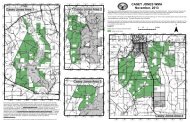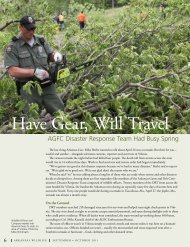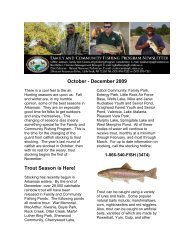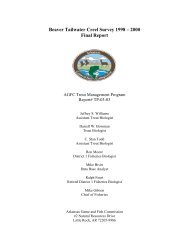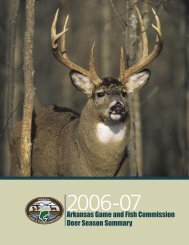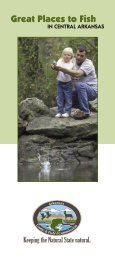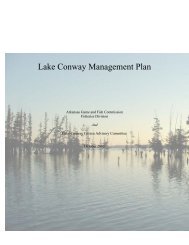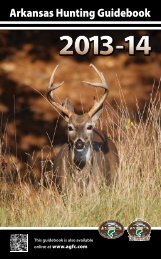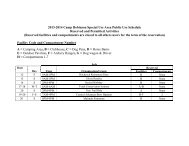View Article - Arkansas Game and Fish Commission
View Article - Arkansas Game and Fish Commission
View Article - Arkansas Game and Fish Commission
- No tags were found...
Create successful ePaper yourself
Turn your PDF publications into a flip-book with our unique Google optimized e-Paper software.
naturally speakingDead Lake <strong>Fish</strong> AreCommon PhenomenaBruce Cunningham with his first striped bass, whichhappens to be the Missouri state record. Photo courtesyof Missouri Department of Conservation.Missouri Record Has<strong>Arkansas</strong> RootsIf fishing were basketball, the <strong>Arkansas</strong> <strong>Game</strong><strong>and</strong> <strong>Fish</strong> <strong>Commission</strong> would earn an assist forthe latest Missouri state-record striped bass.Bruce Cunningham of Fordl<strong>and</strong>, Mo., caughta 60-pound, 9-ounce striper at about 1 a.m.,June 18, on Bull Shoals Lake, which straddlesthe Missouri-<strong>Arkansas</strong> state line.Stripers exist in the lake because of a stockingmistake in 1998. According to Ken Shirley,an AGFC district fisheries supervisor, 19,000striped bass bound for Norfork Lake wound upin Bull Shoals.“We were expecting a shipment of walleyefor Bull Shoals,” Shirley said. “A summer helpercalled to tell us that a shipment of fish hadarrived at the hatchery <strong>and</strong> asked where theywere supposed to go. We thought it was thewalleyes, so we told him to take them to BullShoals. It turned out they were striped bass.”Shirley says survivors of that stocking weighbetween 30 <strong>and</strong> 60 pounds <strong>and</strong> are near theend of their lives. Cunningham’s record was 47inches long with a 36-inch girth. He caught iton a plastic minnow in about 40 feet of water.It topped the 58-pound record caught by JohnWest of Republic, Mo., in July, 2010.Dead fish appearing in Bull Shoals, Norfork <strong>and</strong> Beaver lakes in northern<strong>Arkansas</strong> is a natural <strong>and</strong> seasonal phenomenon, according to Ken Shirley,a veteran district fisheries supervisor with the <strong>Arkansas</strong> <strong>Game</strong> <strong>and</strong> <strong>Fish</strong><strong>Commission</strong>.“High springtime inflows into the large reservoirs are a great benefit to ourfisheries,” Shirley said. “The resulting huge spawns of crappie, walleye <strong>and</strong>largemouth bass often dominate those lake fisheries for years. Similar spawns ofthreadfin or gizzard shad, sunfish, <strong>and</strong> invertebrates result in fast growth of allour game fish. However, this is not without its cost. Access to our waters is oftenlimited or even damaged.“Organic matter like leaves flushed into the lakes decays, taking up oxygenin the cold water below the thermocline (the point where shallow, warm watermeets cold, deep water). While many cool-water fish like walleye <strong>and</strong> striped bassconcentrate at the thermocline where they can acclimate to the temperature <strong>and</strong>water-quality conditions, there is also often a deep plume of cold, oxygenatedwater flowing along the bottom, which also has fish.”Shirley says fish that use that deep plume of oxygenated water have to travelup through a deep or anoxic area to reach more abundant oxygen.“Many do not make it,” Shirley said. “If they do, they may find the surfacewater too hot for them to acclimate quickly or their gas bladder exp<strong>and</strong>s so muchthat they pop to the surface, unable to swim back down, eventually dying fromthe bends or temperature shock.”Striped bass, walleye <strong>and</strong> yellow perch were the most common fish founddead in September on two of the lakes. Beaver Lake doesn’t have a population ofyellow perch, although a few walleye <strong>and</strong> striped bass died there.Bull Shoals Lake is not stocked with striped bass, although it holds some olderfish from stocking. Beaver Lake has a revitalized population of walleye. Yellowperch, smaller relatives of walleye, are not a significant sport fish in <strong>Arkansas</strong> butare a food source for stripers, walleye <strong>and</strong> other predator fish.“<strong>Fish</strong> kills like this occur in normal high-water years on Norfork, preventingits stripers from reaching the huge size for which they are capable,” Shirley said.“Larger fish are affected sooner than smaller ones. Bull Shoals <strong>and</strong> Beaver, withless fertile water, usually suffer these kills only after extreme high-water eventssuch as this year. High water temperatures speed up the oxygen depletion,making this year even worse than would have been expected from high inflowsalone.“While these fish kills were anticipated this year – <strong>and</strong> on Bull Shoals <strong>and</strong>Norfork may be severe enough that anglers notice the temporary decline inwalleye <strong>and</strong> striper populations – the increase in food <strong>and</strong> great spawns will beeven more apparent in the future. These fish kills usually occur over a period ofweeks <strong>and</strong> will end when the surface water temperatures decline enough that thelayers begin to mix.”26ARKANSAS WILDLIFE NOVEMBER • DECEMBER 2011




